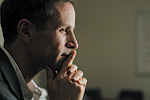


 |
Issue Contents :: Feature Stories :: Relevant
To The Times :: Page [ 1 2 3 ]
A provocative mix of the stark and the subtle, of the sober and the sassy, and with an emphasis on visuals and style, the Sunday magazine tries to offer a little something for everyone. It wants you to grin. It also wants to be taken seriously. There are the signature theme issues: the "Year in Ideas" has become iconic. The front-of-the-book "The Way We Live Now" section helps explain the Moss sensibility. So do such cover stories as the 2001 profile of Jonathan Lebed, the New Jersey teenager whose brilliant Internet stock manipulation scheme crystalized the threat to entrenched institutions posed by smart kids with networked computers in their bedrooms. Michael Lewis, one of a stable of scribes recruited for the magazine by Moss' team, sculpted a cultural milestone with the Lebed story. Engaging us with lucid distillations of society-warping trends is what the magazine under Moss wanted most.
 |
"Adam was brave enough and smart enough to see that you could report on those phenomena with the same rigor and analytical thinking that the paper might have brought to politics or foreign policy—and not think of that as just light fluff or filler," says writer Margaret Talbot, whose cover stories for Moss explored such touchy topics as the RU-486 abortion pill, conservative Christians as a new counterculture, and the urge to clone.
"The way we talked about it internally is that we would break ideas," Moss says—let the newspaper break the news.
Colleagues say that Moss can be very demanding and ungenerous with praise—but that in his relentless drive to capture the Zeitgeist, he is very civil. No histrionics in his style. Just endless interrogation.
Daniel Zalewski, a former Sunday magazine editor now at The New Yorker, says Moss rejected about eight story ideas for every one he accepted—and that was just from staff writers. "He will not stand for the worthy but dull story," says Zalewski. "Adam likes to provoke. He's obsessive about novelty. The freshness you see in the magazine comes from his not being a complacent curator. He always demands that ideas be razor-sharp from the beginning."
That served the magazine well when the 9/11 terror attacks blindsided a sleeping nation. The news business suddenly got very competitive. "We were in a position to step back and say, ‘OK, how is the world organizing itself in a different way and how do we think about that?'" says Moss.
A June 2003 Times piece with near perfect intellectual pitch, written by Dan Baum, helped answer that question. After an invasion of Iraq that critics said relied on too few soldiers, Baum examined the American military's outsourcing of non-combat duties to civilian contractors, who supplement and substitute for soldiers, sentries, and spies. It was one of those pieces competitors wish they'd done first and as well. Events prior and subsequent to the story's publication bear it out: Three U.S. civilian contractors in Colombia have been held captive in the jungle for months by rebels after their drug crop-monitoring plane went down. Three more, bodyguarding a U.S. diplomat, were killed in Gaza in October by a cell-phone-triggered bomb.
Some media watchers think the Sunday magazine, whose circulation of 1.67 million is wholly dependent upon the rest of the paper, could actually expand its readership were it uncoupled from the broadsheet. In advertising, it ranked fourth this year among all U.S. magazines, with 2,196 ad pages by the end of September—a 2 percent increase from 2002. Others have mixed feelings about the magazine under Moss. New York magazine media critic Michael Wolff last year called it less bloated, but also less authoritative than its predecessor, which was more a house organ for long pieces typically penned by star Times correspondents or by major newsmakers themselves. Wolff branded Moss' journal "oddly detached." But he also grudgingly called it "required reading…a damned responsibility and obligation."